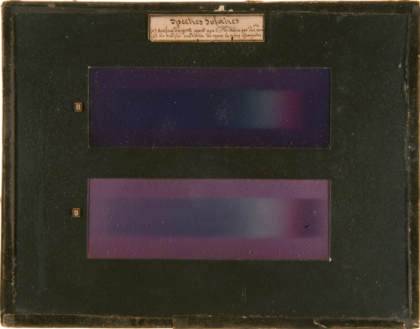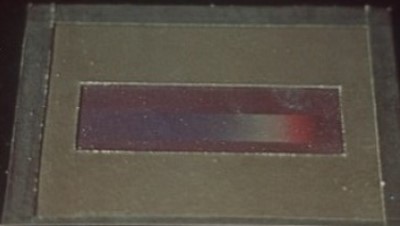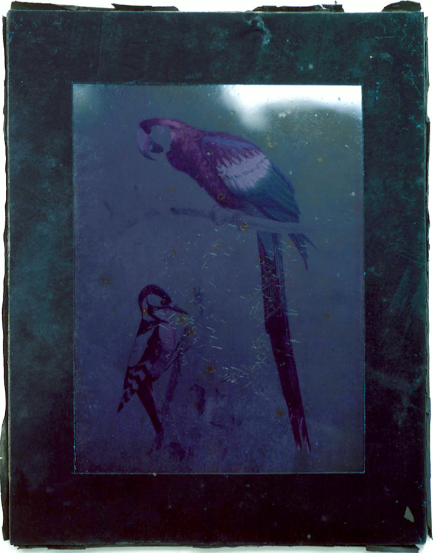First colour photo |
|||||
1. The technology |
2. The human subject |
||||
First colour photo |
|||||
|
'Tartan Ribbon', by James Clark Maxwell (1831–1879), is generally described as the first colour photograph, and will be described below. But this statement isn't really correct. The earliest colour photographs were attempts at photographing colour direct, without colour separations. They all proved to be blind alleys in the development of colour photography, but nevertheless some of these early colour photographs do still survive, and do exhibit colour with a degree of success. Earliest of these attempts was probably that by Sir John Frederick William Herschel, FRS (1792–1871), who obtained, on 9 July 1839, a good colour photograph of the spectrum, but was unable to fix the colours. [Gernsheim, p91; Schröter, pp148-9] The colour sensitivity of silver chloride had, however, been discovered in 1810 by Johann Thomas Seebeck (1770–1831). [Schröter, pp146–7; Eder, pp153–5]
|
|||||
 Becquerel, Spectres solaires, 1848; from p19 of de Seauve; the originals are two of four exemplars held by the Musée Nicéphore Niépce at Chalon-sur-Saône |
 Becquerel, 'Photograph of the Solar Spectrum, Obtained by Direct Color Reproduction', 1848; from the collection of the Musée des arts et métiers—CNAM, Paris (inv. 09728-000-000) (CNAM website) |
||||
|
The earliest demonstrably successful experiments produced the surviving images of the solar spectrum realised in 1848 by Alexandre-Edmond Becquerel (1820–1891) on metal plates sensitised with silver chloride. The colours are clearly visible in both plates depicted above. Eder states that Becquerel's process retains the colour image "as long as subsequent light action is avoided." [Eder, p665] In 2020 new research has shown that the colours obtained by Becquerel were due to the presence of metallic silver nanoparticles. [CNRS press release; de Seauve]
Becquerel achieved more than this, though: a plate of his, depicting a stuffed parrot, was shown at the 1855 International Exhibition in Paris. According to the celebrated photographer Nadar "The reproduction of this parrot held gray, blue, and red hues of a remarkable intensity." The bird was apparently nicknamed 'The Susceptible Parrot', as light acted irresistibly on the colour, and the image could only be viewed in a small black-veiled tent. [Pénichon, p8] This may well be the image reproduced above, which appears to be of a scarlet macaw and a woodpecker, and is actually a contact print from a colour engraving.
|
|||||
 Hill, Landscape from Nature, c. 1850–1855; Photographic History Collection, National Museum of American History, Smithsonian Institution, Washington DC; from p9 of Pénichon |
|||||
|
In 2007 the Smithsonian Institution established that some of the experimental daguerreotypes taken by Levi L. Hill (1816–1865), using his 'heliochromy' process (images commonly referred to as Hillotypes) do exhibit natural colours—genuinely albeit very weakly. The example depicted, in which the colour (not to mention the subject) is barely discernible, is dated earlier than the best example to be seen on the Internet, which is the Hillotype of a colour lithographic print of a girl and an animal, dated by the Smithsonian to circa 1851–1856. [Delaney]
|
|||||
 Niepce de Saint-Victor, Poupée sur un tabouret (Doll on a Stool), 1851–1859; Musée des arts et métiers—CNAM, Paris (inv. 10516-0001-001) |
|||||
|
In the 1850s Claude Felix Abel Niepce de Saint-Victor (1805–1870; cousin to Nicéphore) carried out experiments not only on the solar spectrum (revisiting Becquerel's experiments) but photographing coloured objects with a camera. The experimental images weren't stable, but one of his heliochromes, 'fixed' with a form of varnish, was said to show brilliant colours forty years after it had been made [Coe]; and an 1867 Niepce heliochrome owned by Eder still presented "unchanged a remarkable liveliness of color" as much as sixty years later. [Eder, p666] Niepce de St Victor had in fact photographed still lifes, including a bouquet of flowers, and portraits of dolls. One of his doll heliochrome images is reproduced above. The image is actually pretty clear, though faded, and colours—particularly red and blue-green—are quite distinct. This image, and images of two other heliochromes, may be found on the CNAM website.
|
|||||
 Maxwell, Tartan Ribbon, photograph presented in 1861 |
|||||
|
Though clearly not the first colour photograph, it could be argued that this is at any rate the first colour photograph produced by colour separations. However it has recently been argued that it can't even really be claimed as a photograph. See below for more on this. James Clerk Maxwell (1831–1879) had the photographer Thomas Sutton (1819–1875)—a colleague at Kings and editor of Photographic News, who had particular research interests in colour and stereoscopy himself—photograph a tartan ribbon three times, each time with a different colour filter over the lens. The three images were developed and then projected onto a screen with three different projectors, each equipped with the same colour filter used to take its image. When brought into focus, the three images formed a full colour image. This was demonstrated at a public lecture by Maxwell on 17 May 1861, at the Royal Institution in London. The three photographic plates are now held by a small museum at 14 India Street, Edinburgh, the house where Maxwell was born. About a hundred years later a team at Kodak established that the success of this experiment had been a fluke, as Sutton's emulsions were insensitive to red light, and the red fabric dyes were actually also reflecting in the near ultra-violet, which was being passed by his deep-red ferric thiocyanate filter. [Mahon, James Clerk Maxwell's Big Mistake] Maxwell had in fact outlined this practical demonstration of Thomas Young's theory of colour vision in a communication to the Royal Society of Edinburgh in 1855, but without actually carrying it out. Notably, neither he nor Sutton ever repeated the demonstration. In 2013 Jordi Cat, whilst on the one hand drawing attention to the significance of Sutton's contribution to the 1861 experiment, rightly questioned whether it is appropriate to refer to this single projection of the tartan ribbon as a 'photograph'. In his view, "The peculiarity of the Maxwell-Sutton episode resides in the fact that the identity of its photographic elements and their color status does not fit the standards of colored photographic record adopted by the project and purpose of the photography of the time." This is because the colour images "are not chemically fixed and realized on a shareable medium independent of another source (as are the colorless primary negatives on the slides); they are not printed." Even Sutton himself called the projection only "a sort of photograph". Tartan Ribbon was never printed as a colour photograph until D.A. Spencer's 1937 Vivex carbro print made from the original negatives, of which an image appears on the National Science and Media Museum website. [Cat, Roberts] A better version—a digital reconstitution from Spencer's duplicates of Maxwell and Sutton's positives—appears on p11 of Pénichon. 2021 update: At a webinar given by the Victoria and Albert Museum on 4 November 2021 by wetplate collodion photographer Paul Elter, it was established that in fact the projected image didn't actually show the real colours at all. The orthochromatic emulsions couldn't capture the true colours of green or blue, and the three separation negatives were different in their density because of different exposure times; so while the colour filters when projected did display three different colours, these didn't at all represent the colours of the actual ribbon. The tartan ribbon, as the 'first colour photograph' should now be regarded as essentially an urban myth.
|
|||||
|
This section wouldn't be complete without reference to three other pioneers of colour photography, Charles Cros (1842–1888), Louis Ducos du Hauron (1837–1920), and Gabriel Lippmann (1845–1921. Cros and du Hauron both achieved colour printing as early as 1869, although Cros was marginally the earlier to submit photographic proof to the Société Français de Photographie. [Coote] The earliest surviving image by du Hauron is probably the 1869 image of leaves and flower petals on the website of the Musée Nicéphore Niépce; it was one of three presented by du Hauron to the SFP on 7 May that year, in whose collection it remains (inv. III-EP-024a); the reproduction in Pénichon (p16) includes the mount, the photographer's signature, the date 1869, and his title for the image, Trichromie rétrospective, anciens essais. His 1877 view of Agen, France, is his most familiar and widely available image, but earlier images of Agen survive, such as this from 1875. Early images by Cros are much more inaccessible: the only one located so far is here, (with a larger version, but watermarked, here). According to Pénichon only a few of Cros's prints survive; one from c. 1869—a still life entitled La Table—is reproduced at p128 of her work; the trichrome print is in the Bibliothèque centrale du Museum d'histoire naturelle, Paris. Lippmann's process is not so early, but is wholly unique as to the process he developed, which to this day is the only true and permanent direct representation of natural colours recorded without the use of dyes, by encoding optical interference patterns. He first reported the successful recording of the spectrum on 2 February 1891. [Hannouch, ed.] Following a refinement by the Lumières of the emulsion he used, in 1892 he was able to present pictorial images at a combined meeting of all the French photographic societies. Subjects on show included a group of flags, a plate of oranges, a stained-glass window, and a stuffed bird. [Hannouch, ed.]
|
|||||
|
|
|||||
First colour halftone print |
|||||
|
|
|||||
|
Adapting Hermann Vogel's three-colour process, and with the assistance of Vogel's son Ernst, the German-American photographer William Kurtz (1833–1904) spent six months during 1892 experimenting with halftone colour printing, eventually achieving a satisfactory result. His still life of fruit on a table was published on New Year's Day 1893 in Vogel's photography journal Photographische Mittheilungen; it was later republished in the USA as the frontispiece of the March 1893 issue of The Engraver and Printer. In the production of this image Kurtz had used single line screens, of which the blue block lines were at 45° to the left of vertical, the red lines 45° to the right, and the yellow lines 90° to the vertical. Kurtz had invested over $200,000 into his experiments, but hadn't patented his results, so for him personally the invention meant financial failure. [Sipley, Hirsch]
|
|||||
|
|
|||||
First colour photocopy |
|||||
|
In the late 1950s coloured toners were used experimentally with Electrofax copiers, and Haloid made seven colour copiers for the Disney Studios, which were used to create the animation cels for One Hundred and One Dalmatians (released 1961). (Nicholson) The technique had earlier been tested on a few animated shorts, including Goliath II in 1960 (Yetikyel).Full-colour copiers were not commercially available, however, until 3M released the Color-in-Color copier in 1968.
|
|||||
| © 2009–2024 Benjamin S. Beck |
If you know of any earlier examples, please contact me.
|
|

